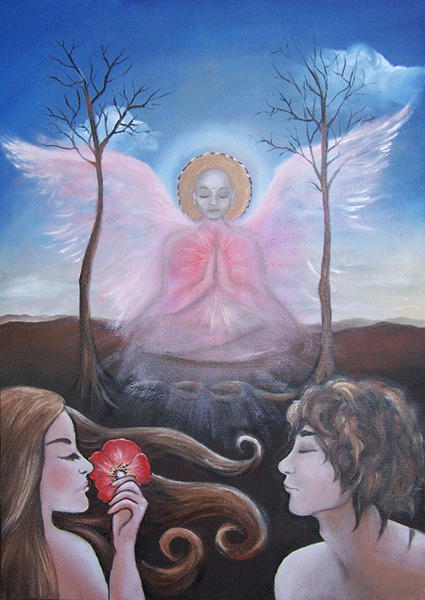
Sitting and meditating lately about what is really life about that makes up get up in the morning and carry on as artists…
Is it how much money you got in the bank? The partner of our dreams? That new car you been saving up? The Exhibition you booked for?
Or is it the peace of mind, security and happiness that all this acquirements provide us?
What is really life about?
It’s very easy to confuse values with goals, but they are very different – goals are specific ways in which you might express your values…
Now, think for yourself, what you really value in your life? You might say “my job”, but then ask yourself “What is your job in the service of?” You might answer “Financial security”. Keep asking the same question “What is financial security in the service of?” Keep on asking the question until can’t find an answer and you have found your value.
Values are what life is about, and it it’s all about happiness. Know your values! Happiness is what makes my life worth for, ask yourself!
Everything else my dear collegues, it will before long turn to dust…

Angela,
Does the woman on the right remember the beauty and innocence that she gave up in facing life, qualities still expressed by the woman on the left?
Oddly enough, my first thought after reading your lines was ‘discipline’, the discipline not to overwork.
I love the bold strokes in your painting.
Welcome back!
Birgit… I was trying to paint a man and a woman… the one on the right is a man.
Angela,
My interpretation reveals where I stand, a woman identifying herself with masculine behavior, indications of my age and life-style.
Thank you for the insight.
I was trying to paint a man and a woman… the one on the right is a man.
Angela, according to The Da Vinci Code, Leonardo struggled with the same thing :)
I like your use of classical structure in the painting: the choice of a triangular layout and the almost-symmetry from left to right. There seem to be two worlds represented here, the physical world of the two foreground figures and the dream/imaginary/spiritual world of the central figure. Interesting that you use the woman’s hair to imply an energy movement from her to the man.
I agree with David, the structure of your painting is very strong. As recently mentioned regarding Tree’s project, the overall symmetry enhances our attention on symmetry-breaking elements, like the flower and hair. I also like the strong contrast of the human figures against the dark background, vs. the subdued contrast, almost merging, of the buddha/mother angel in the sky.
Interestingly, people are amazingly bad at predicting what will or won’t make them happy. At least, that’s the message of a lot of studies cited in Stumbling on Happiness, a very engaging read.
Lovely painting, Angela. I especially like the profile of the man with his Adam’s apple sticking out.
I’m not completely sure about equating values with happiness. That sounds more like equating happiness with value. Values are something you are supposed to sacrifice for, stand for even if they make you unhappy. Or am I missing the point?
I like your use of classical structure in the painting: the choice of a triangular layout and the almost-symmetry from left to right.
Good point, David. In this context, the subtle form of the cloud on the upper right is interesting in the way it challenges this balance.
Angela, welcome back.
The comments above all point to the elements that strike me. I was also struck by the fact that all the figures have their eyes closed. And the male figure on the right seems more yearning than the female figure on the left, even if her hair does belie her slightly withdrawn features.
I’m reminded of Keats’ Ode to a Grecian Urn: “Thou still unravished bride of quietness,/ Thou foster child of silence and slow time…/ Heard melodies are sweet, but those unheard/ Are sweeter; therefore ye soft pipes play on…/ Bold Lover, never, never canst thous kiss,/ Though winning near the goal — yet do not grieve;/ She cannot fade, though thou hast not thy bliss,/ Forever wilt thou love, and she be fair.” This is the poem that ends with the famous lines, “‘Beauty is truth, truth beauty,'” that is all / Ye know on earth, and all ye need to know.”
[My ancient Norton anthology says these last lines might be a “universal and profound metaphysical proposition, or an overstatement uttered in the course of a dramatic dailogue, or simply nonsense.”]
At any rate, you and Keats are circling the same questions, although you may arrive at different answers.
Angela:
Very nice painting.
I do have a question: is the painting all one thought? I see the spiritual figure and then the two very concrete people in the foreground. I want to think of them as engaged in a visual dialog together, but my attention tends to jump from one to another. I was thinking earlier that maybe the two foreground figures are engaged with each other in front of a depiction – perhaps a painting – of the spiritual being. Or are they all living in the same moment?
Angela,
I hate to be the one who is going to ask you this, but why is this painting less detailed than the majority of works by you that I have had the privilege of seeing? To elaborate: The angles wings and the rays radiating out over the intertwined roots seem to be less detailed than normal. Is this the way you wanted it to be? I am curious… You could tell me to be quiet and just appreciate the painting, but I had to ask…